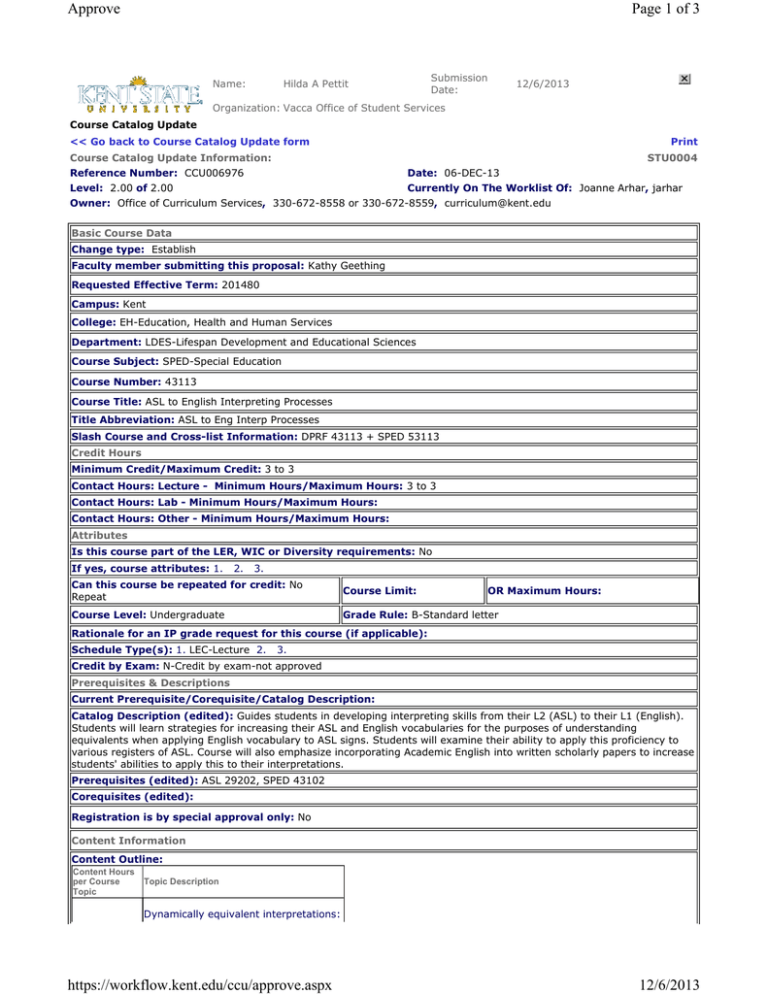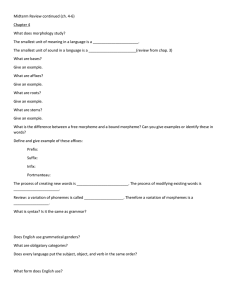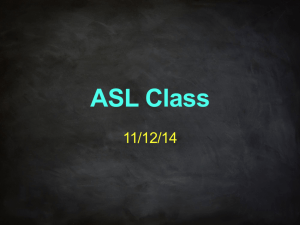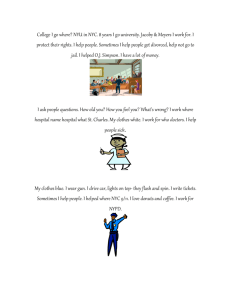of Submission Name:
advertisement

Approve Page 1 of 3 Name: Submission Date: Hilda A Pettit 12/6/2013 Organization: Vacca Office of Student Services Course Catalog Update << Go back to Course Catalog Update form Print Course Catalog Update Information: STU0004 Reference Number: CCU006976 Date: 06-DEC-13 Level: 2.00 of 2.00 Currently On The Worklist Of: Joanne Arhar, jarhar Owner: Office of Curriculum Services, 330-672-8558 or 330-672-8559, curriculum@kent.edu Basic Course Data Change type: Establish Faculty member submitting this proposal: Kathy Geething Requested Effective Term: 201480 Campus: Kent College: EH-Education, Health and Human Services Department: LDES-Lifespan Development and Educational Sciences Course Subject: SPED-Special Education Course Number: 43113 Course Title: ASL to English Interpreting Processes Title Abbreviation: ASL to Eng Interp Processes Slash Course and Cross-list Information: DPRF 43113 + SPED 53113 Credit Hours Minimum Credit/Maximum Credit: 3 to 3 Contact Hours: Lecture - Minimum Hours/Maximum Hours: 3 to 3 Contact Hours: Lab - Minimum Hours/Maximum Hours: Contact Hours: Other - Minimum Hours/Maximum Hours: Attributes Is this course part of the LER, WIC or Diversity requirements: No If yes, course attributes: 1. 2. 3. Can this course be repeated for credit: No Repeat Course Limit: Course Level: Undergraduate Grade Rule: B-Standard letter OR Maximum Hours: Rationale for an IP grade request for this course (if applicable): Schedule Type(s): 1. LEC-Lecture 2. 3. Credit by Exam: N-Credit by exam-not approved Prerequisites & Descriptions Current Prerequisite/Corequisite/Catalog Description: Catalog Description (edited): Guides students in developing interpreting skills from their L2 (ASL) to their L1 (English). Students will learn strategies for increasing their ASL and English vocabularies for the purposes of understanding equivalents when applying English vocabulary to ASL signs. Students will examine their ability to apply this proficiency to various registers of ASL. Course will also emphasize incorporating Academic English into written scholarly papers to increase students' abilities to apply this to their interpretations. Prerequisites (edited): ASL 29202, SPED 43102 Corequisites (edited): Registration is by special approval only: No Content Information Content Outline: Content Hours per Course Topic Topic Description Dynamically equivalent interpretations: https://workflow.kent.edu/ccu/approve.aspx 12/6/2013 Approve 15 3 9 6 3 9 Page 2 of 3 producing ASL to English interpretations given a variety of settings, registers, and consumers while incorporating Academic English and advanced English vocabulary. Advanced ASL and English vocabulary expansion. Examining English and ASL: grammar, puncutation, fragments, phonology. Written translations: Applying correct English grammar and vocabulary to written English translations of ASL texts. Oral presentations: taped presentations to examine their spoken English proficiency: grammatically, lexically, and prosodically. Evaluate their ability to identify and produce appropriate characterisitics of each register. Linguistic conflicts between the two languages: Passive and active voice, prepositions, verb tenses, pluralizations, pronominalization. Display/Hide Delimited Course Outline Total Contact Hours: 45 Textbook(s) used in this course: Kelly, J.E., ASL to English interpretation: Say it like they mean it. Al exandria, VA: RID Press; Smith, R. Kent Building vocabulary for college. Wadsworth, Cengage Learning. Writing Expectations: Scholary academic paper written on an assigned topic. Written analysis of voiced interpretations. Grad students will produce two academic papers and interpretation analysis. Instructor(s) expected to teach: SPED Faculty Instructor(s) contributing to content: Pam Luft Proposal Summary Explain the purpose for this proposal: This is a new course created for the ASL English Interpreting concentration to reinforce and expand English and ASL grammatical knowledge and to increase the quantity and quality of students' vocabulary in each language for the purposes of applying this information to interpretations. Professional sign language interpreters need to be masters, not only of English (L1), but of their second language (L2,) as well. Research has shown that L1 success predicts a language learner's success in L2. Sign language interpreters are then constrained by their success in L2 based on their facility with the English language. This course will enable them to have a firm foundation and confidence in English with which to apply new information in ASL. Students need to be familiar with register nuances between English and ASL and develop the facility to match registers in their interpretations. An emphasis in this course will be connecting grammar and vocabulary of students' L1 to a corresponding equivalent in their L2 (ASL). In addition to linguistic differeneces between the two languages, interpreting from a manual-visual language to an aural-oral language creates unique demands on the interpreter's shortterm memory, processing time, and English proficiency. Students struggle to visually receive an incoming ASL message and mentally determine its meaning - while simultaneously producing a spoken message applying correct English grammar and selecting appropriate English vocabulary. This skills requires extensive practice to develop and current curriculum does not afford the concentrated focus required. The students will do the following: 1). write scholarly papers and give oral presentations on topics demonstrating Academic English; 2). compile lists of diverse lexical synonyms from L1 to L2; 3) create categories of English and ASL vocabulary respective of different registers; 4). produce receptive interpretations and written translations which include correct English grammar and word choices; 5). produce receptive interpretations which include correct English grammar and several lexical iterations in different registers. Through the applications of these learning strategies, the students will be able to do the following: 1). incorporate advanced vocabulary in their speaking, writing, and receptive interpretations; 2). develop their receptive processing through consecutive and simultaneous interpretations; 3) analyze their English proficiencey and develop strategies for improvement; 4). identify vocabulary differences between registers; 5). produce ASL to English interpretations that demonstrate appropriate decisions regarding grammar, vocabulary, and register; 6). produce dynamically equivalent interpretations. Explain how this proposal affects program requirements and students in your unit: This course is a new required addition to the interpreting curriculum. A significant portion of an interpreter's work involves producing appropriate translations from ASL to English. This skill is also a critical component of the national certification exam. The interpreting curriculum does not currently have a course dedicated to this essential skill. Total graduation credits will remain the same. SPED 43010 is being removed from the program because content is not pertinent to the work of an interpreter. Explain how this proposal affects courses, program requirements and student in other units: This will not impact other students or programs. Explain how this proposal affects enrollment and staffing: https://workflow.kent.edu/ccu/approve.aspx 12/6/2013 Approve Page 3 of 3 All interpreting majors will be required to take this course. The College Dean has approved hiring a new faculty member to support the ASEI program. With the hiring of this full-time NTT instructor, no additional faculty will be needed. Units consulted (other departments, programs or campuses affected by the proposal): No other dept or program is affected by this proposal. Dr. Pam Luft was consulted reqarding the creation of this class. Comments (500 Character Maximum): NOTE: Please do not use the following restricted characters: (~ * / \ --) Approve Comments: Date 12/6/2013 Return To Initiator User Susan M Augustine Return To Prior Approver Deny Comment No comments available. History: Date User Status 12/6/2013 Susan M Augustine Approved 12/6/2013 Susan M Augustine Submitted https://workflow.kent.edu/ccu/approve.aspx 12/6/2013






